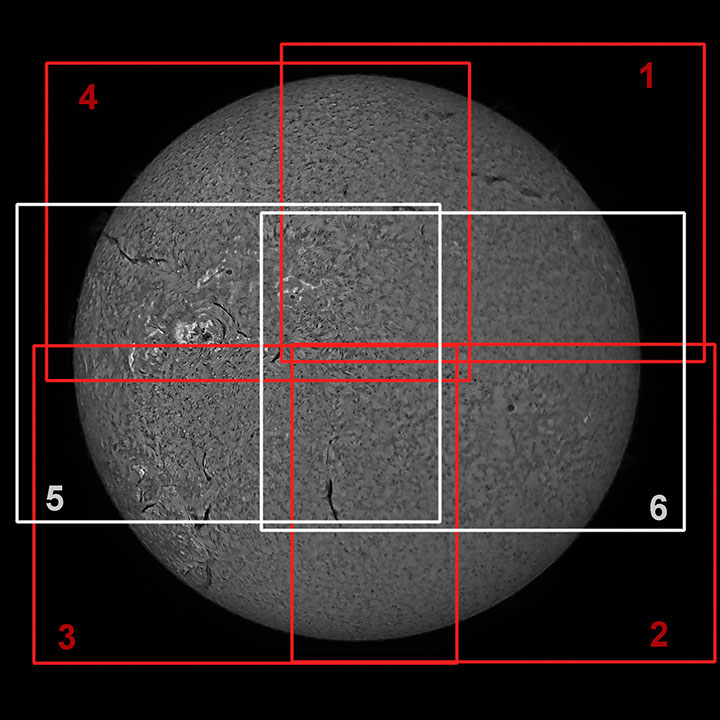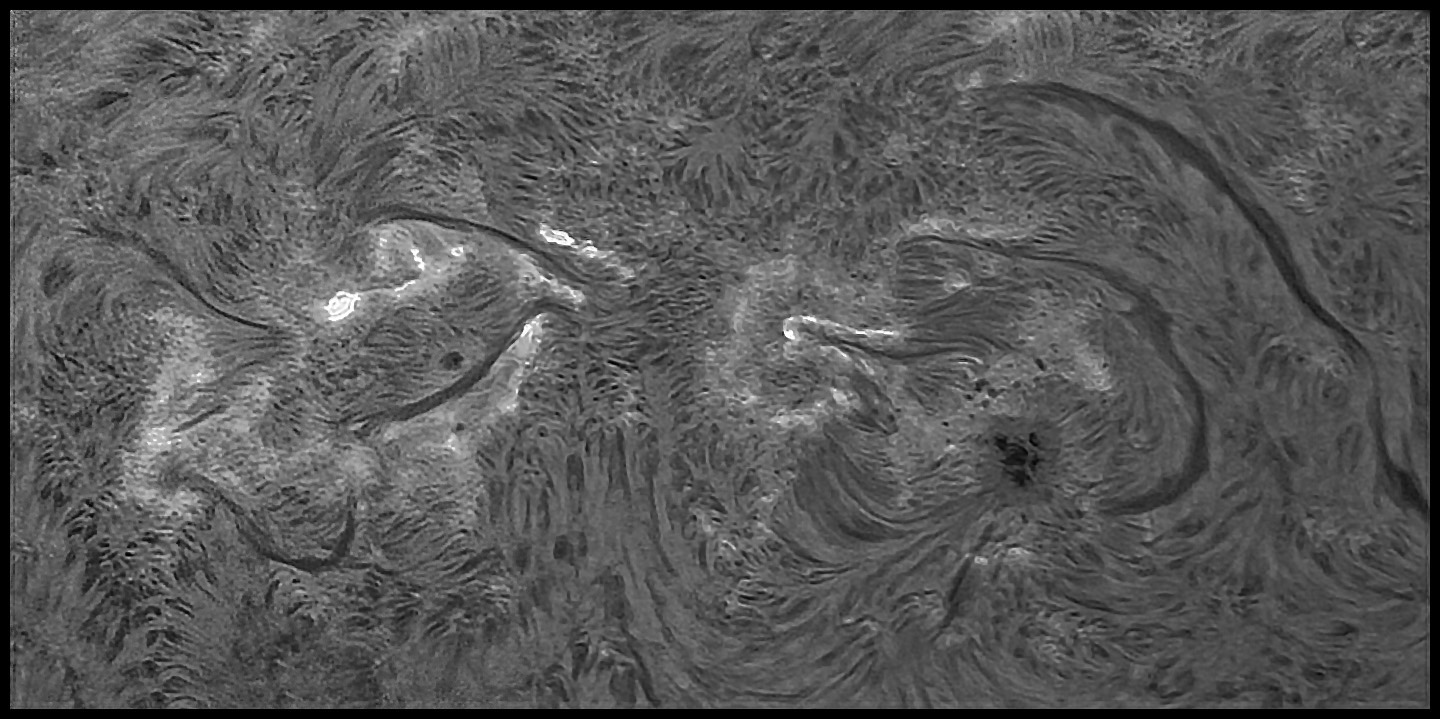Refining Yesterday's Guesses
06/10/2024. Really, aren't we always? The full-disk mosaics still rely more on guesswork than on a solid workflow. Here's my recollection of today's adventure with provisional advice. The flat was hard to come by -- keep the gain low, leave the gamma off. Center the focussed Sun as best the chip allows, and use two layers of USPS white plastic. The flat exposures will be almost a second long; the filtered shots will run about one thousand times shorter. I tried a cropped 4x mosaic which failed in the photomerge step. So did a 6x unflatted mosaic though for different reasons. One failed to find alignment across all images; the other lost control of the highlights in part of the stitched image. To address both issues, turn the vignette control option off in photomerge, and give it some details to hang its hat on. A 4x straight-from-the-camera mosaic worked, but a 4x mosaic made from pseudo-flatted subframes worked better. Adding a pair of equatorial subs should have helped out, but it's not clear that they did or that their help was needed. Whatever. Shoot 'em and use 'em if needed. Today, this worked:

Best 100 of 500 times six.

The schema: clips 1-4 may suffice; 5 & 6 may help.
The new kid is developing quickly, but I have no idea if the physics of its magnetic fields will produce appreciable fireworks as it transits the Sun.

Best 1,000 from first 5,000 of a 10,000 frame clip.
I tried resetting the declination drift 5,050 frames into the clip. Don't. In Firecapture, I used a region of interest of about 1,000 x 800 which allowed something like 41 frames per second. Exposure 1.6ms, Gamma 32. Then AutoStakkart!4 with 842 alignment points, drizzled 3x. I applied very mild noise reduction in Photoshop just because and then pseudo-flatfielded the stack (backed off to 65%). I used ImPPG per usual, and finally tweaked the image in Photoshop with curves and a small bit of unsharp masking.
And another thing: don't get too taken with 10,000 frame clips of small regions of interest. Here's almost the full chip's field of view built from only ("only") 1,000 frames. Post-processing was similar to the close-up above. The workflow for these tighter views seems robust across a range of acquisition scales and parameters.

Best 200 of 1,000 frames
That view seems much sharper, so let's revisit typical viewing geometries, circles of confusion, and what enlargements are really all about. I don't mean right now, of course, but soon.
06/11/2024. I thought the full-disk stuff was coming along. And it is, compared to last week's or last year's, but today's best is a step back from yesterday's or the day before's. I don't know why. That's why it's interesting. And infuriating. Even if I work like crazy to get smooth tones across the disk, some quarters (some parts of quarters) are blurred, stretched, unsharp while others are fine. One thing: when doing sequential mosaics like this, use a high fraction of the clips' frames to avoid getting luckier with one section than with another. My mosaic made with 200 of 500 frames worked better than the same effort using 50 out of 500 frames. Four component images worked better than six. This time. Overall, the effect is like looking at the full-disk image at the top of this page through nasty cataracts.
The close-up action worked well enough, a 1,000 frame wide view worked out, as did a 10,000-frame R.O.I. image. So did a 2x3,000 frame panorama. I'll probably post those by and by, but right now, I am too puzzled about the full-disk problems to be really excited about the closer views.
Oh, hell, I worked 'em up. Let's take a look.

Not bad, but not so good either. And so much work! 4x200 out of 500 frames, lots
of post-production flat-fielding using both new and old ways of working.

Best 500 of 10,000. No preprep before pseudo-flat. ImPPG then USM.
Resampled down using Photoshop's "Bicubic (smooth gradiants)" preset.
Yeah, yeah: embiggen it.
If you've actually read this page, you might note that that previous image violates a couple of plausibly important guidelines: it covers a relatively small ROI (about 1000 x 800 pixels) and it's refined from 10,000 frames. OK, smartass, here's a panorama almost twice as wide from two ROIs very much like the previous one and therefore displayed at roughly half the scale. This one uses the best 100 of 3,000 frames for each half of the frame. And yeah, as in yesterday's example, the reduced pixel scale results in a sharper presentation.
 Click it!
Click it!
I'm really liking this "downsample smoothly" option. The things I'm still discovering about Photoshop after all these years!*
6/12/2024. Milky skies but steady seeing. I thought the changing transparency would be a challenge for cranking out a 4-frame full-disk mosaic. It actually worked out very well, which is nice, but it would be better to know why. I made use of 200 of the 500 frames hoping they would average out to some semblance of consistency. Just so. I don't think that fully explains today's good result. I fed "photomerge" the stacked files straight from AS!4 and spent just a few minutes tweaking lighting and sharpness. Then I added histogram adjustments and color.

Four clips, best 200 of 500 frames each, full-frame captures. Clicking permitted!

Two builds, best 500 out of 5,000 frames, 1000x700-pixel R.O.I.s.
Gave "Shake correction" a try. Why not?
Clicking encouraged.
There were a couple of others, but these two worked especially well. You know how it goes: I'll keep pecking away at the others until I can't stand not posting them. Just not right now.
___________
* 33 at last count
:: top ::